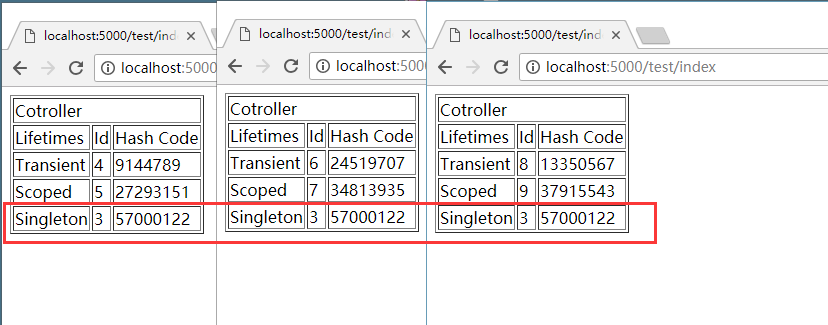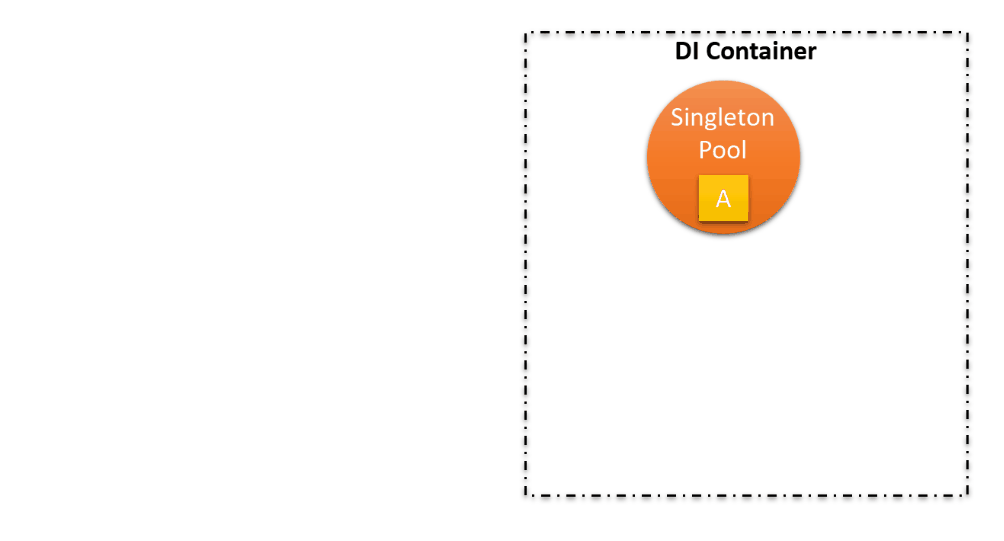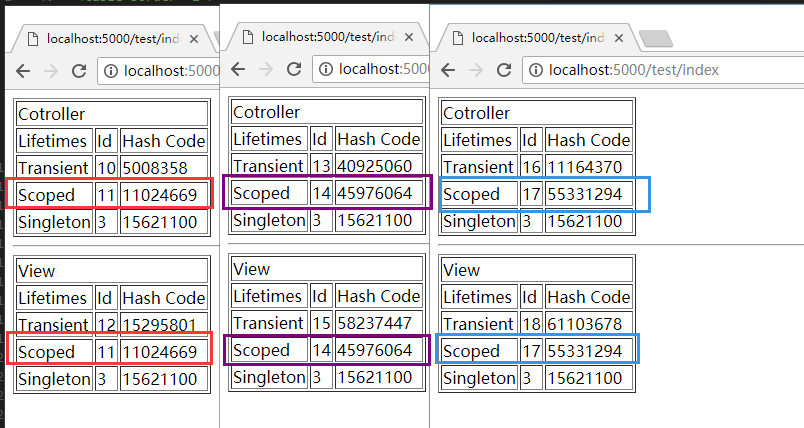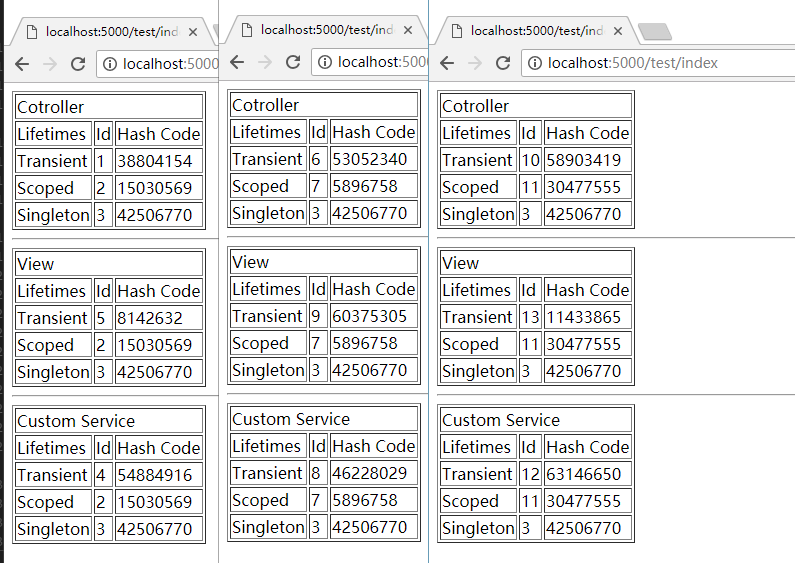ASP.NET Core使用了大量的依赖注入(Dependency Injection, DI),把控制反转(Inversion Of Control, IoC)运用的相当巧妙。DI可算是ASP.NET Core最精华的一部分,有用过Autofac或类似的DI Framework对此应该不陌生。
本篇将介绍ASP.NET Core的依赖注入(Dependency Injection)。
DI 容器介绍
在没有使用DI Framework 的情况下,假设在UserController 要调用UserLogic,会直接在UserController 实例化UserLogic,如下:
public class UserLogic {
public void Create(User user) {
// ...
}
}
public class UserController : Controller {
public void Register(User user){
var logic = new UserLogic();
logic.Create(user);
// ...
}
}
以上程序基本没什么问题,但是依赖关系差了点。UserController 必须要依赖UserLogic才可以运行,拆出接口改成:
public interface IUserLogic {
void Create(User user);
}
public class UserLogic : IUserLogic {
public void Create(User user) {
// ...
}
}
public class UserController : Controller {
private readonly IUserLogic _userLogic;
public UserController() {
_userLogic = new UserLogic();
}
public void Register(User user){
_userLogic.Create(user);
// ...
}
}
UserController 与UserLogic 的依赖关系只是从Action 移到构造方法中,依然还是很强的依赖关系。
ASP.NET Core透过DI容器,切断这些依赖关系,实例的产生不在使用方(指上例UserController构造方法中的new),而是在DI容器。
DI容器的注册方式也很简单,在Startup.ConfigureServices注册。如下:
Startup.cs
// ...
public class Startup
{
public void ConfigureServices(IServiceCollection services)
{
services.AddMvc();
}
}
services就是一个DI容器。
此例把MVC的服务注册到DI容器,等到需要用到MVC服务时,才从DI容器取得对象实例。
基本上要注入到Service的类没什么限制,除了静态类。
以下示例就只是一般的Class继承Interface:
public interface ISample
{
int Id { get; }
}
public class Sample : ISample
{
private static int _counter;
private int _id;
public Sample()
{
_id = ++_counter;
}
public int Id => _id;
}
要注入的Service需要在Startup.ConfigureServices中注册实例类型。如下:
Startup.cs
// ...
public class Startup
{
public void ConfigureServices(IServiceCollection services)
{
// ...
services.AddScoped<ISample, Sample>();
}
}
- 第一个泛型为注入的类型
建议用Interface来包装,这样在才能把依赖关系拆除。 - 第二个泛型为实例的类型
DI 运行方式
ASP.NET Core的DI是采用Constructor Injection,也就是说会把实例化的物件从建构子传入。
如果要取用DI容器内的物件,只要在建构子加入相对的Interface即可。例如:
ControllersHomeController.cs
using Microsoft.AspNetCore.Mvc;
using MyWebsite.Models;
namespace MyWebsite.Controllers
{
public class HomeController : Controller
{
private readonly ISample _sample;
public HomeController(ISample sample)
{
_sample = sample;
}
public string Index()
{
return $"[ISample]
"
+ $"Id: {_sample.Id}
"
+ $"HashCode: {_sample.GetHashCode()}
"
+ $"Tpye: {_sample.GetType()}";
}
}
}
输出内容如下:
[ISample]
Id: 1
HashCode: 52582687
Tpye: MyWebsite.Models.Sample
ASP.NET Core 实例化Controller 时,发现构造方法中有ISample 这个类型的参数,就把Sample 的实例注入给该Controller。
每个Request 都会把Controller 实例化,所以DI 容器会从构造方法注入ISample 的实例,把sample 存到变量_sample 中,就能确保Action 能够使用到被注入进来的ISample 实例。
注入实例过程,情境如下:

Service 生命周期
注册在DI 容器的Service 分三种生命周期:
- Transient
每次注入时,都重新new一个新的实例。 - Scoped
每个Request都重新new一个新的实例,同一个Request不管经过多少个Pipeline都是用同一个实例。上例所使用的就是Scoped。 - Singleton
被实例化后就不会消失,程式运行期间只会有一个实例。
小改一下Sample 类的代码:
namespace MyWebsite.Models
{
public interface ISample
{
int Id { get; }
}
public interface ISampleTransient : ISample
{
}
public interface ISampleScoped : ISample
{
}
public interface ISampleSingleton : ISample
{
}
public class Sample : ISampleTransient, ISampleScoped, ISampleSingleton
{
private static int _counter;
private int _id;
public Sample()
{
_id = ++_counter;
}
public int Id => _id;
}
}
在Startup.ConfigureServices中注册三种不同生命周期的服务。如下:
public class Startup
{
public void ConfigureServices(IServiceCollection services)
{
services.AddTransient<ISampleTransient, Sample>();
services.AddScoped<ISampleScoped, Sample>();
services.AddSingleton<ISampleSingleton, Sample>();
// Singleton 也可以用以下方法注册
// services.AddSingleton<ISampleSingleton>(new Sample());
}
}
Service Injection
只要是透过WebHost产生实例的类型,都可以在构造方法注入。
所以Controller、View、Filter、Middleware或自定义的Service等都可以被注入。
此篇我只用Controller、View、Service做为范例。
Controller
在TestController 中注入上例的三个Services:
ControllersTestController.cs
using Microsoft.AspNetCore.Mvc;
using MyWebsite.Models;
namespace MyWebsite.Controllers
{
public class TestController : Controller
{
private readonly ISample _transient;
private readonly ISample _scoped;
private readonly ISample _singleton;
public TestController(
ISampleTransient transient,
ISampleScoped scoped,
ISampleSingleton singleton)
{
_transient = transient;
_scoped = scoped;
_singleton = singleton;
}
public IActionResult Index()
{
ViewBag.TransientId = _transient.Id;
ViewBag.TransientHashCode = _transient.GetHashCode();
ViewBag.ScopedId = _scoped.Id;
ViewBag.ScopedHashCode = _scoped.GetHashCode();
ViewBag.SingletonId = _singleton.Id;
ViewBag.SingletonHashCode = _singleton.GetHashCode();
return View();
}
}
}
ViewsTestIndex.cshtml
<table border="1">
<tr><td colspan="3">Cotroller</td></tr>
<tr><td>Lifetimes</td><td>Id</td><td>Hash Code</td></tr>
<tr><td>Transient</td><td>@ViewBag.TransientId</td><td>@ViewBag.TransientHashCode</td></tr>
<tr><td>Scoped</td><td>@ViewBag.ScopedId</td><td>@ViewBag.ScopedHashCode</td></tr>
<tr><td>Singleton</td><td>@ViewBag.SingletonId</td><td>@ViewBag.SingletonHashCode</td></tr>
</table>
输出内容如下:

从左到又打开页面三次,可以发现Singleton的Id及HashCode都是一样的,现在还看不太能看出来Transient及Scoped的差异。
Service 实例产生方式:

图例说明:
- A为Singleton对象实例
一但实例化,就会一直存在于DI容器中。 - B为Scoped对象实例
每次Request就会产生新的实例在DI容器中,让同Request周期的使用方,拿到同一个实例。 - C为Transient对象实例
只要跟DI容器请求这个类型,就会取得新的实例。
View
View注入Service的方式,直接在*.cshtml使用@inject:
ViewsTestIndex.cshtml
@using MyWebsite.Models
@inject ISampleTransient transient
@inject ISampleScoped scoped
@inject ISampleSingleton singleton
<table border="1">
<tr><td colspan="3">Cotroller</td></tr>
<tr><td>Lifetimes</td><td>Id</td><td>Hash Code</td></tr>
<tr><td>Transient</td><td>@ViewBag.TransientId</td><td>@ViewBag.TransientHashCode</td></tr>
<tr><td>Scoped</td><td>@ViewBag.ScopedId</td><td>@ViewBag.ScopedHashCode</td></tr>
<tr><td>Singleton</td><td>@ViewBag.SingletonId</td><td>@ViewBag.SingletonHashCode</td></tr>
</table>
<hr />
<table border="1">
<tr><td colspan="3">View</td></tr>
<tr><td>Lifetimes</td><td>Id</td><td>Hash Code</td></tr>
<tr><td>Transient</td><td>@transient.Id</td><td>@transient.GetHashCode()</td></tr>
<tr><td>Scoped</td><td>@scoped.Id</td><td>@scoped.GetHashCode()</td></tr>
<tr><td>Singleton</td><td>@singleton.Id</td><td>@singleton.GetHashCode()</td></tr>
</table>
输出内容如下:

从左到又打开页面三次,Singleton的Id及HashCode如前例是一样的。
Transient及Scoped的差异在这次就有明显差异,Scoped在同一次Request的Id及HashCode都是一样的,如红紫篮框。
Service
简单建立一个CustomService,注入上例三个Service,代码类似TestController。如下:
ServicesCustomService.cs
using MyWebsite.Models;
namespace MyWebsite.Services
{
public class CustomService
{
public ISample Transient { get; private set; }
public ISample Scoped { get; private set; }
public ISample Singleton { get; private set; }
public CustomService(ISampleTransient transient,
ISampleScoped scoped,
ISampleSingleton singleton)
{
Transient = transient;
Scoped = scoped;
Singleton = singleton;
}
}
}
注册CustomService
Startup.cs
public class Startup
{
public void ConfigureServices(IServiceCollection services)
{
// ...
services.AddScoped<CustomService, CustomService>();
}
}
第一个泛型也可以是类,不一定要是接口。
缺点是使用方以Class作为依赖关系,变成强关联的依赖。
在View 注入CustomService:
ViewsHomeIndex.cshtml
@using MyWebsite
@using MyWebsite.Models
@using MyWebsite.Services
@inject ISampleTransient transient
@inject ISampleScoped scoped
@inject ISampleSingleton singleton
@inject CustomService customService
<table border="1">
<tr><td colspan="3">Cotroller</td></tr>
<tr><td>Lifetimes</td><td>Id</td><td>Hash Code</td></tr>
<tr><td>Transient</td><td>@ViewBag.TransientId</td><td>@ViewBag.TransientHashCode</td></tr>
<tr><td>Scoped</td><td>@ViewBag.ScopedId</td><td>@ViewBag.ScopedHashCode</td></tr>
<tr><td>Singleton</td><td>@ViewBag.SingletonId</td><td>@ViewBag.SingletonHashCode</td></tr>
</table>
<hr />
<table border="1">
<tr><td colspan="3">View</td></tr>
<tr><td>Lifetimes</td><td>Id</td><td>Hash Code</td></tr>
<tr><td>Transient</td><td>@transient.Id</td><td>@transient.GetHashCode()</td></tr>
<tr><td>Scoped</td><td>@scoped.Id</td><td>@scoped.GetHashCode()</td></tr>
<tr><td>Singleton</td><td>@singleton.Id</td><td>@singleton.GetHashCode()</td></tr>
</table>
<hr />
<table border="1">
<tr><td colspan="3">Custom Service</td></tr>
<tr><td>Lifetimes</td><td>Id</td><td>Hash Code</td></tr>
<tr><td>Transient</td><td>@customService.Transient.Id</td><td>@customService.Transient.GetHashCode()</td></tr>
<tr><td>Scoped</td><td>@customService.Scoped.Id</td><td>@customService.Scoped.GetHashCode()</td></tr>
<tr><td>Singleton</td><td>@customService.Singleton.Id</td><td>@customService.Singleton.GetHashCode()</td></tr>
</table>
输出内容如下:

从左到又打开页面三次:
- Transient
如预期,每次注入都是不一样的实例。 - Scoped
在同一个Requset中,不论是在哪边被注入,都是同样的实例。 - Singleton
不管Requset多少次,都会是同一个实例。
参考
Introduction to Dependency Injection in ASP.NET Core
ASP.NET Core Dependency Injection Deep Dive
老司机发车啦:https://github.com/SnailDev/SnailDev.NETCore2Learning